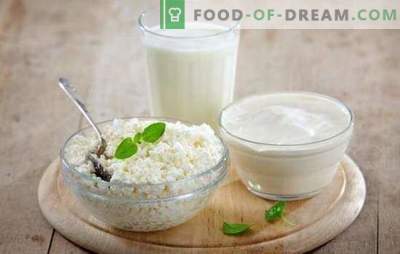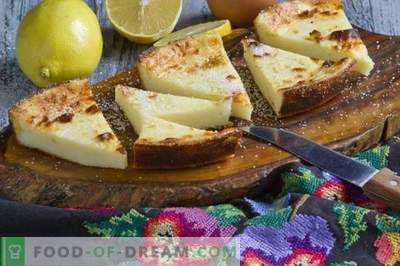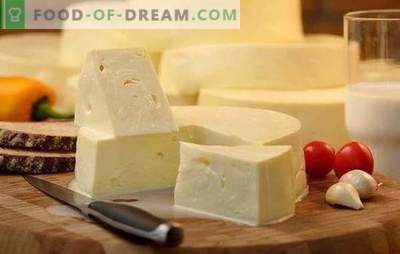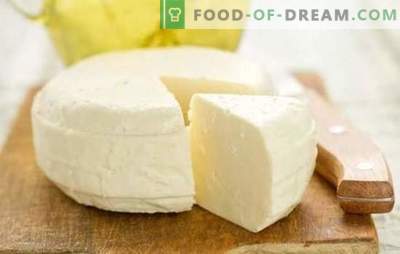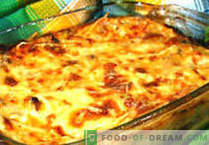
For the first time, humanity learned about cheese making, as historians and archaeologists say, seven thousand years ago. During this time, the technology of cheeses has incredibly expanded, both in terms of the range and in the number of countries in which for tens and even hundreds of years there has been “branded” cheeses.
The first types of cheeses that appeared at the dawn of civilization were made, of course, in an artisanal way, without the use of cooking. Modern analogues of those cheeses are pickled, rennet and cream cheeses.
These types of cheeses are quite can be made at home, because it does not require additional equipment and you can do with the tools and materials that are in the kitchen of each hostess. Moreover, for soft cheeses, there is no need to apply a special leaven in the technology, and in order to curb milk or sour cream, we can limit ourselves to adding any fermented milk product (not pasteurized) or using natural oxidizers: wine or apple vinegar, citric acid or juice.
Why do if you can buy? We will answer this question immediately, and the decision is a personal matter of everyone.
The first and most basic reason is economic feasibility. If you calculate the cost of raw materials for cheese from sour cream and compare it with the retail price for similar types of cheeses in the distribution network, then the benefit itself becomes apparent. The cost of raw materials, equipment, its maintenance, salaries of employees, transportation, advertising, packaging - this is a brief list of what the consumer must pay for. If we exclude from this list everything except the cost of raw materials, then the cost of any cheese will decrease at times.
The second significant reason: each housewife can feel like a real technologist of cheese making and even develop her own recipe, improving, at her discretion, for example, Feta cheese, which seems to her too salty. The third reason arising from the first one: we should not forget that mass production does not take into account the personal tastes of each, but the possibility of saturating the market with goods, from which, among other things, the developed conservation technologies follow to ensure longer shelf life of the product. The shelf life is achieved in various ways: using salt solutions with a high salt content, additives (including those that are not considered too useful) pasteurization, which, if they so desire, does not allow to preserve the taste of natural and fresh product. Home-made sour cream cheese can be made from the fresh product, without any additional processing methods aimed at long-term preservation, in the right quantities and eaten immediately. it is not necessary to add stabilizers and preservatives to it in order to increase shelf life.
Sour cream cheese - general technological principles
In order to cook any kind of sour cream cheese, it is necessary, besides the recipe, to know some of the biochemical features of the main product, from which both sour cream and cheese are obtained.
About Milk and Dairy Products
From pasteurized milk, in a film or a tetra package, you will never get either sour cream or cheese. Having passed all stages of the technological process of processing, natural milk does not contain the fat content that is necessary for sour cream and cheese. In addition, as a result of pasteurization, milk loses the enzymes necessary for the manufacture of cheese, and the protein contained in the product changes its structure as a result of processing and becomes unsuitable for obtaining high-quality fermented milk product.
Based on the foregoing, only natural, whole milk , which is often called “homemade”, is suitable for home-made sour cream and cheese from sour cream . The term “whole” means cow or other milk from which no cream is removed - a fatty part of milk. Milk fat content also depends on several factors: the breed of the animal, its age, quality and high-calorie content of the feed, season of the year and even time of day. For example, milk obtained from evening milk yield contains more cream than milk obtained from the same cow during morning milking. These subtleties must be known when buying farm milk at the markets to make cheese from sour cream. In various glass bottles one can detect the differences of milk visually. The fattest layer, cream, has a thicker consistency and a slightly creamy hue, so the cream floats to the surface, after settling after 3-4 hours. That is, when you come to the market for milk in the morning, choose the bottle in which you can clearly see the detached cream.
Depending on the above factors, the amount of cream can reach 1/3 of the total volume of milk in the bottle. In addition, the milk itself, which is under a layer of cream, also contains much more fat than milk bought in a film, bag or bottle, which has passed through all stages of processing at a dairy plant.
Using a simple arithmetic calculation method, you can determine that 3L of natural, whole milk contains at least 30-33% fat, if you carefully remove the cream floating on the surface without mixing the contents of the bottle. More cream can be obtained by separation - the separation of liquids of different densities. For this purpose, there are domestic separators, although it is not necessary to acquire them.
Even 30% of fat content is quite enough to get homemade sour cream and sour cream cheese. From milk, low-fat or with a low percentage of fat content you can get cottage cheese, or use it in this form for other purposes. You can also make very tasty homemade cheeses from skimmed or low-fat milk and cottage cheese.
Now for the cream. Fresh cream is the raw material for making butter, and sour cream and cheese are made from sour dairy product. Sour cream and yogurt can contribute to sour cream: it is added at 15-20 g per 100 g of fresh cream. For fermentation of cream, you can use special starters containing lactic acid bacteria and enzymes. Natural lactic acid bacteria, in turn, are necessary to obtain creamy, brine and rennet cheeses. Why is home sour cream preferable for making cheese? It is because of the percentage of fat and protein needed for a creamy taste and a soft, delicate texture of cheese. Although, from whole, homemade milk, you can get the same result, but at the same time the product of milk processing into cheese, whey, will increase by several times, which is not profitable at home.
It is much more profitable to buy milk, collect cream from it and continue to use skimmed milk and cream in accordance with the purpose. Skimmed, boiled milk will be completely preserved for 3-4 days in the refrigerator, until its full use in the preparation of various dishes. From the selected cream, meanwhile, sour cream is obtained, within 24-30 hours, and then it is used to make cheese from sour cream.
Cheese can be made from cottage cheese, milk, sour milk or sour cream, provided that these products have sufficient fat, protein and lactic acid. That is, dairy products should not be pasteurized, because heat treatment destroys casein, milk protein, which, in turn, prevents the formation of curd grain (due to lack of acid), the binding of curd mass (due to the destruction of casein structure).
In the manufacture of soft, rennet, cream and pickled cheeses, in any case, you need to get the curd mass. Then it is separated from the whey, pressed and the finished cheese heads are stored in brine (pickle cheeses) or wrapped in a wet cloth and packed in film.
You can slightly complicate the process of making cheese from sour cream and prepare even hard cheese at home by reheating the already obtained curd.
To learn how to do this, read in more detail in the recipes.
Recipe 1. Sour cream cheese - Indian panira cooking technology
This cheese recipe has no name. It only used the old Indian technology of cooking the most delicate homemade cheese.
Ingredients: Cream, fresh 1.4 L
Lemon juice 50-70 ml
Cooking:
Heat fresh cream in an enamel or ceramic saucepan to 70-80ºC, with continuous stirring. Without boiling, pour juice or citric acid solution, without stopping stirring.
As soon as the cream begins to flake off, transfer the contents of the pan to the other container, through the filter. For straining, use a colander, covered with gauze (4 layers) or linen napkin. The colander must be installed above the pan so that serum flows through it, without touching the drip tray.
When abundant fluid separation is complete, tie a cheesecloth and form a disk with rounded edges from the curd in it. Place the cheese on a board installed above the tray, cover with another board, and install a press on the second board. Soak the cheese under a press until it stops flowing.
Pasteurized pressed whey, optionally add salt or lemon juice, or other spices and seasonings. Put the cheese into the hot whey and tightly close the container with the product.
When cool, keep in cold.
Recipe 2. Cheese from sour cream - “Mascarpone” at home
For cooking, beloved by many cheese, according to Italian technology, you will need the same products as in the first recipe. You can use sour cream instead of lemon and to increase the mass. For coagulation, according to the technology of "Mascarpone", also used wine, white vinegar.
Ingredients:
Cream, fat (not less than 35%) - not less than 1,5 l
Natural sour cream (25%) 0.5 l
Lemon juice or vinegar 75-100 ml
Cooking:
Heat the cream in a water bath, but do not need to bring them to a boil.
Pour in sour cream and continue to warm up, stirring constantly. If the process of coagulation begins, you can not add lemon juice. When the separation of the serum will appear clearly, remove the pan from the stove and stir the mass for some time so that the serum separates better.
Pour the contents of the pan into a prepared cotton cloth, well permeable to the liquid. Tie the edges of the material in a knot so that it can be hung. Substitute the pan or any container for draining the whey from the mass in the suspended position. Press in this case is not necessary to use, since the pressing of the cheese will occur under pressure of its own weight. Depending on the air temperature and the natural humidity in the room, pressing can take from 2-3 to 8-10 hours. When the indoor temperature is above 25 ° C, put the cheese in the fridge by hanging it over the top shelf and setting the pan.
Recipe 3. Sour cream cheese with paprika
Ingredients:
Cream (30%) 400 ml
Cottage cheese (whole milk) 1 kg
Sour cream (at least 25%) 500 g
Salt, dried paprika (chopped) and greens to taste
Citric acid 5 g
Cooking:
Curd with spices and sour cream to kill a blender.
Pour the cream into a double-bottom stewpan, add grated cottage cheese with other ingredients and, while stirring constantly, heat to 50-60 ° C.
Turn off the stove and add citric acid without interrupting the stirring. Chill the mass, to a temperature of 20 - 25 ° C, fold it onto a prepared colander, covered with gauze, leave to drain, placing the lid or cutting board on which you want to install, for example, a jar filled with water, so that the cheese is on the press.
Soak it in this position for at least 10-12 hours.
Recipe 4. “Dutch” sour cream cheese
If you have patience, you can cook semi-hard cheese yourself. Only for cooking you need to take raw materials so much that in the process of full maturity you get a head weighing at least 1 kg. The fat content of the cheese should be at least 45% therefore add sweet, butter.
Ingredients:
Sour cream (50%), homemade 1.5 kg
Cottage cheese (from whole, not pasteurized milk) 2 kg
Butter, cream (82.5%) 1.2 kg
Milk, not pasteurized (whole) 1.0 l
Extra salt, finely ground 7-8 g
Acidophilic yeast (sourdough) 30 g
Cooking:
Sour cream and cottage cheese in a homogeneous mass. You can use a mixer, but at low speeds, so as not to destroy the structure of casein.
Add salt (sea salt cannot be used) and ferment.
Transfer the resulting mass to a large container, with milk heated in it (up to 30 ° C) and knead until a homogeneous consistency, so that the salt dissolves and the yeast begins to work. Maintain the temperature, without stopping stirring, until the serum peel begins. When the milk mass is curled, pass it through the prepared gauze filter, but do not overdry the curd grain. Its moisture content should remain at least 50%, relative to the moisture content of the milk.
Add the softened butter and knead until thick and thick sour cream is obtained, without grains.
Put the cheese dough in a water bath and heat, maintaining a temperature of 50-60 ºC, with continuous stirring. When the mass begins to melt, forming layered fibers, the heating should be stopped, but continue to mix the dough until cooling (25-30 ° C) until the temperature becomes comfortable in order to form the bar with your hands.
Lubricate the surface and hands with oil (serum can be used to wet the hands). Using rectangular-shaped cutting boards (preferably wooden), form the dough and compact it by pressing. Cheese should be put in a form with holes in it and put on ripening (45-60 days) in a cool place (10-12ºC).
Form the cheese in a larger container with a tight-fitting lid; At the bottom of this form, pour a layer of salt, which will serve as a barrier to foreign odors and bacteria, as well as absorb the moisture emitted by the cheese during drying.
On the 10th and 20th day, the air temperature should be increased by 5ºC and then reduced again to the initial one. During ripening, the cheese must be turned over to evenly form a crust.
After the initial drying for the first day, change the salt litter: instead of it, pour a 20% salt solution on the bottom of the protective mold chamber, which will simultaneously maintain the humidity.
For the last 10-15 days of ripening, keep the cheese in a dry chamber, without salt. If mold develops during ripening, wash the surface of the cheese with saline solution (20%), in warm water (up to 40ºC). After that, the cheese should be poured with a jet of hot air (a hairdryer can be used), and again placed in the chamber.
Recipe 5. Cheese from sour cream “Cheese”
Under production conditions and on farms, brynza is made of whole, not pasteurized milk, which has sufficient volume, fat content and live milk bacteria. In addition, for the manufacture of a type of cheese, ferment or rennet is also used. Salt solution is also used to give a special taste and cheese storage. Playing a technological chain for cooking this type of cheese in the home kitchen is not at all difficult. But for home-made cheese, in order to get 50% fat content that meets the standards, and saves consumables, part of the milk should be replaced with fat sour cream.
Ingredients:
Sour cream (50%) or cream (of the same fat content) 3.0 l
Milk (9-10%) 1.0 l
Salt 12-15 g
Sourdough (if using fresh cream) 30 g
Cooking:
Mix the milk and sour cream (or cream) in an enamel bowl, mix, add the leaven and leave until the curd clot has a gel-like consistency. It is desirable for this operation to choose a conveniently shaped container in order to be able to cut the resulting mass without the need to transfer future cheese to another container.
Cutting the clot large (1.5x2cm), you need to put the tank on the steam bath (30ºC); first let it stand for an hour, and then begin to mix it gently, no more than half an hour, in circular motions, with stops after 3-4 minutes.
Remove 2/3 volume of the whey (do not throw it away, store it in the refrigerator) and add salt for the remainder. Within 5 hours, turn the pieces of cheese in this brine 2-3 times.
Until full readiness, it is stored in salted brine, at 15-16ºC, 5-7 days.
Then put in a sour brine. Cheese is ready.
Recipe 6. Cream cheese sour cream
Ingredients:
Milk, whole 1 part
Natural sour cream 25% 1.5 parts
Cooking:
It is advisable to prepare the cheese in a water bath to provide a temperature of 70-80 ºC.
In this case, a thermometer can be installed in a large container and the heating temperature can be regulated by adding water. Pour non-pasteurized milk (preferably homemade) into smaller dishes. When adding sour cream, mix with a whisk to get a uniform, thick mass.
More mixed cheese mass can not. Leave it at room temperature for curdling.
After 5-7 hours, when the whey separates (it will be visible on the surface of the mass), place this container in a large dish with water and begin to warm up until the mass is compacted to gelatinous condition.
If there is a lot of cheese, you can make cuts with a knife, but not destroy the resulting structure.
Remove the saucepan with cheese from the water and cool. Turn on a sieve to separate the serum, setting the drip pan, for 7-8 hours.
Recipe 7. Sour cream cheese: children's glazed curds
Ingredients:
Sour cream 25-30% 0.5 kg
Cottage cheese, fat 1 kg
Cream (20%) 1.5 L
Glaze (chocolate)
Icing sugar, vanilla
Cooking:
Combine sour cream and cottage cheese, killing them with a blender. Heat the cream, but do not boil. Add to them a mixture of cottage cheese and sour cream, sugar and vanilla. Stir the whole mass and allow the whey to separate.
Then cut the formed dense layer into equal pieces of rectangular or square shape; put them on a wooden board or grate with a small section (sieve) to allow the whey to drain and dry.
When the surface of the pieces dries, powder it (with powdered sugar or starch) and pour it with melted icing. To do this, pre-line the baking sheet with foil and place the semi-finished products on it.
Then keep the cheese in the cold, so that the icing froze; Remove the baking sheet and the lower part of the curds, left uncovered, dip them in the glaze, again putting them on the baking sheet, turning the non-frozen part upwards. Once again, hold in the cold and put it in a container or dish.
Sour cream cheese - useful tips and tricks
- Do not pour out the whey remaining after making the cheese. It will make an excellent unleavened dough for dumplings; whey will fit for yeast dough. In this case, homemade cheese production will be completely cost-effective and waste-free.
- The addition of salt, in the manufacture of cheese, compresses the cheese and reduces its moisture. Consider this nuance.
- Eating cheese is good, so it’s worth including in your daily diet. In the process of ripening cheese, milk proteins break down, forming a large number of essential amino acids.
- Hard cheeses have a higher fat content than soft and pickled ones, so those who follow weight should be given preference for the latter types.

